
A skin-tight garment is a garment that is held to the skin usually by elastic tension using some type of stretch fabric. Commercial stretch fabrics ('elastomerics') such as spandex or elastane came onto the market in 1962, and revolutionized many areas of the clothing industry. A wide variety of clothing may be made to be skin-tight, and it is common for clothing to be skin-tight for some uses, such as in stockings, bodystockings, swimsuits and women's bras.

A wetsuit is a garment worn to provide thermal protection while wet. It is usually made of foamed neoprene, and is worn by surfers, divers, windsurfers, canoeists, and others engaged in water sports and other activities in or on water. Its purpose is to provide thermal insulation and protection from abrasion, ultraviolet exposure, and stings from marine organisms. It also contributes extra buoyancy. The insulation properties of neoprene foam depend mainly on bubbles of gas enclosed within the material, which reduce its ability to conduct heat. The bubbles also give the wetsuit a low density, providing buoyancy in water.

A swimsuit is an item of clothing designed to be worn by people engaging in a water-based activity or water sports, such as swimming, diving and surfing, or sun-orientated activities, such as sun bathing. Different types may be worn by men, women, and children. A swimsuit can be described by various names, some of which are used only in particular locations, including swimwear, bathing suit, swimming costume, bathing costume, swimming suit, swimmers, swimming togs, bathers, cossie, or swimming trunks for men, besides others.
Speedo International Limited is a British distributor of swimwear and swim-related accessories based in Nottingham, England, known for its swim briefs. The company has roots in Australia but is not based there anymore. Founded in Sydney in 1914 by Alexander MacRae, a Scottish emigrant, the industry-leading company is now a subsidiary of the British Pentland Group. Today, the Speedo brand can be found on products ranging from swimsuits and goggles to wristwatches. The Speedo brand was previously manufactured for and marketed in North America as Speedo USA by PVH, under an exclusive perpetual licence, which had acquired prior licensee Warnaco Group in 2013. As of January 2020, the Pentland Group purchased back the rights from PVH for $170 million in cash, subject to regulatory approval.
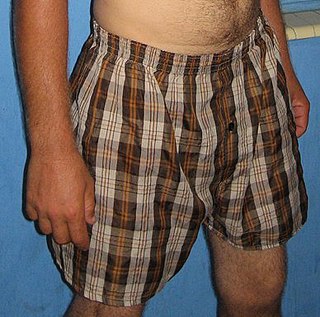
Boxer shorts are a type of undergarment typically worn by men. The term has been used in English since 1944 for all-around-elastic shorts, so named after the shorts worn by boxers, for whom unhindered leg movement ("footwork") is very important. Boxers come in a variety of styles and design but are characterized by their loose fit.
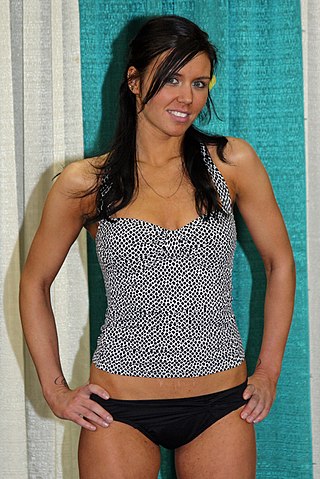
The tankini is a bathing suit combining a tank top, mostly made of spandex-and-cotton or Lycra-and-nylon, and a bikini bottom introduced in the late 1990s. This type of swimwear is considered by some to provide modesty closer to a one-piece suit with the convenience of a two-piece suit, as the entire suit need not be removed in order to use a toilet. Tankinis come in a variety of styles, colors, and shapes, some include features such as integrated push-up bras. It is particularly popular as children's beachwear, and athletic outfit good enough for a triathlon. According to Katherine Betts, Vogue's fashion-news director, this amphibious sportswear for sand or sea lets users go rafting, play volleyball, and swim without worrying about losing their top.

Boardshorts are a type of swimwear and casual wear in the form of long loose-fitting shorts that are designed to be quick-drying and are generally made from strong and smooth polyester or nylon material. Originally known as surf trunks, later as Jams, and occasionally in British English as swim shorts, boardshorts are a style of men's and, more recently, women's summerwear.

Competitive swimwear refers to the swimsuit, clothing, equipment, and accessories used in the aquatic sports of swimming, diving, synchronized swimming, triathlon, and water polo.
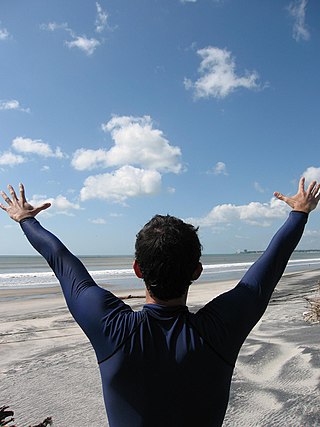
A rash guard, also known as rash vest or rashie, is an athletic shirt made of spandex and nylon or polyester. The name rash guard reflects the fact that the shirt protects the wearer against rashes caused by abrasion, or by sunburn from extended exposure to the sun, as sun protective clothing.
High-technology swimwear, or tech suits, are scientifically advanced materials used for swimwear in competitive water sports such as swimming and triathlon. Materials of this type are normally spandex and nylon composite fabrics with features to reduce drag against the water. The fabrics include features that increase the swimmer's glide through water and reduce the absorption of water by the suit as opposed to regular swimsuits.

Swim trunks, also known as swimming trunks, are a form of swimsuit - clothing worn specifically for swimming. As such, they are usually made of materials specifically designed for being wet and remaining comfortable and hydrodynamic to not impede the swimmer. The choice of materials makes them distinct from underwear which may have a similar shape. The term is a catch-all for a number of styles of garment - briefs, shorts and "jammers".
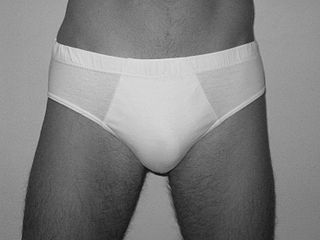
Briefs are a type of short, form-fitting underwear and swimwear, as opposed to styles where material extends down the thighs. Briefs have various different styles, usually with a waistband attached to fabric that runs along the pelvis to the crotch and buttocks, and are worn by both men and women. Swim briefs are a variation used as swimwear.
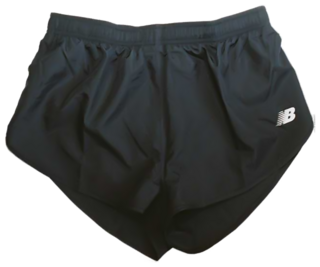
Gym shorts are an article of clothing typically worn by people when exercising. They are typically made out of fabrics that allow for maximum comfort and ease, such as nylon. Brands such as Nike, Under Armour, Adidas, and Reebok all make gym shorts. Cotton gym shorts were made popular by a cheerleading brand called Soffe. Gym shorts or sweatpants are required for many junior high and high school physical education courses.
Jantzen is a brand of swimwear that was established in 1916 and first appeared in the city of Portland, Oregon, United States. The brand name later replaced the name of the parent company that manufactured the branded products. The brand featured a logo image of a young woman, dressed in a red one-piece swimsuit and bathing hat, assuming a diving posture with outstretched arms and an arched back. Known as the Jantzen "Diving Girl", the image in various forms became famous throughout the world during the early twentieth century.

The LZR Racer is a line of competition swimsuits manufactured by Speedo using a high-technology swimwear fabric composed of woven elastane-nylon and polyurethane. The swimsuits are made in body-length; they compress the body and trap air for buoyancy. The LZR Pro and LZR Elite were launched on 13 February 2008; the higher-priced LZR Elite was replaced by the LZR Elite 2 in early 2014. The LZR X, the most recent addition to Speedo's competition suit lineup, was launched in early 2015. The technology is patented in Italy, and protected worldwide.

Underwear, underclothing, or undergarments are items of clothing worn beneath outer clothes, usually in direct contact with the skin, although they may comprise more than a single layer. They serve to keep outer clothing from being soiled or damaged by bodily excretions, to lessen the friction of outerwear against the skin, to shape the body, and to provide concealment or support for parts of it. In cold weather, long underwear is sometimes worn to provide additional warmth. Special types of undergarments have religious significance. Some items of clothing are designed as undergarments, while others, such as T-shirts and certain types of shorts, are appropriate both as underwear and outerwear. If made of suitable material or textile, some underwear can serve as nightwear or swimwear, and some undergarments are intended for sexual attraction or visual appeal.

Many stylistic variations of the bikini have been created. A regular bikini is a two-piece swimsuit that together covers the wearer's crotch, buttocks, and breasts. Some bikini designs cover larger portions of the wearer's body while other designs provide minimal coverage. Topless variants are still sometimes considered bikinis, although they are technically not a two-piece swimsuit.
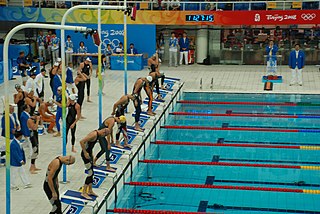
Swimming is an individual or team racing sport that requires the use of one's entire body to move through water. The sport takes place in pools or open water. Competitive swimming is one of the most popular Olympic sports, with varied distance events in butterfly, backstroke, breaststroke, freestyle, and individual medley. In addition to these individual events, four swimmers can take part in either a freestyle or medley relay. A medley relay consists of four swimmers who will each swim a different stroke, ordered as backstroke, breaststroke, butterfly and freestyle.

The history of competitive swimwear has been dominated by concerns over public nudity in the first half of the 20th century and by efforts to reduce water drag in the second half. Those efforts initially led swimmers to reduce the early sagging one-piece swimsuits down to briefs only. With the development of new materials that tightly fit the body and offered lower resistance to water than human skin, this trend was reversed to a complete body coverage from heels to neck and wrists. FINA banned full-body suits from competition effective from 1 January 2010, stating that it "wishes to recall the main and core principle is that swimming is a sport essentially based on the physical performance of the athlete".
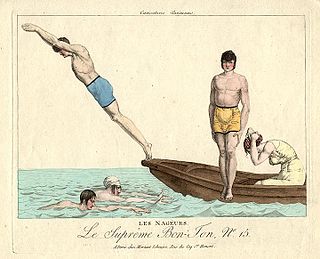
The history of swimwear traces the changes in the styles of men's and women's swimwear over time and between cultures, and touches on the social, religious and legal attitudes to swimming and swimwear.




















